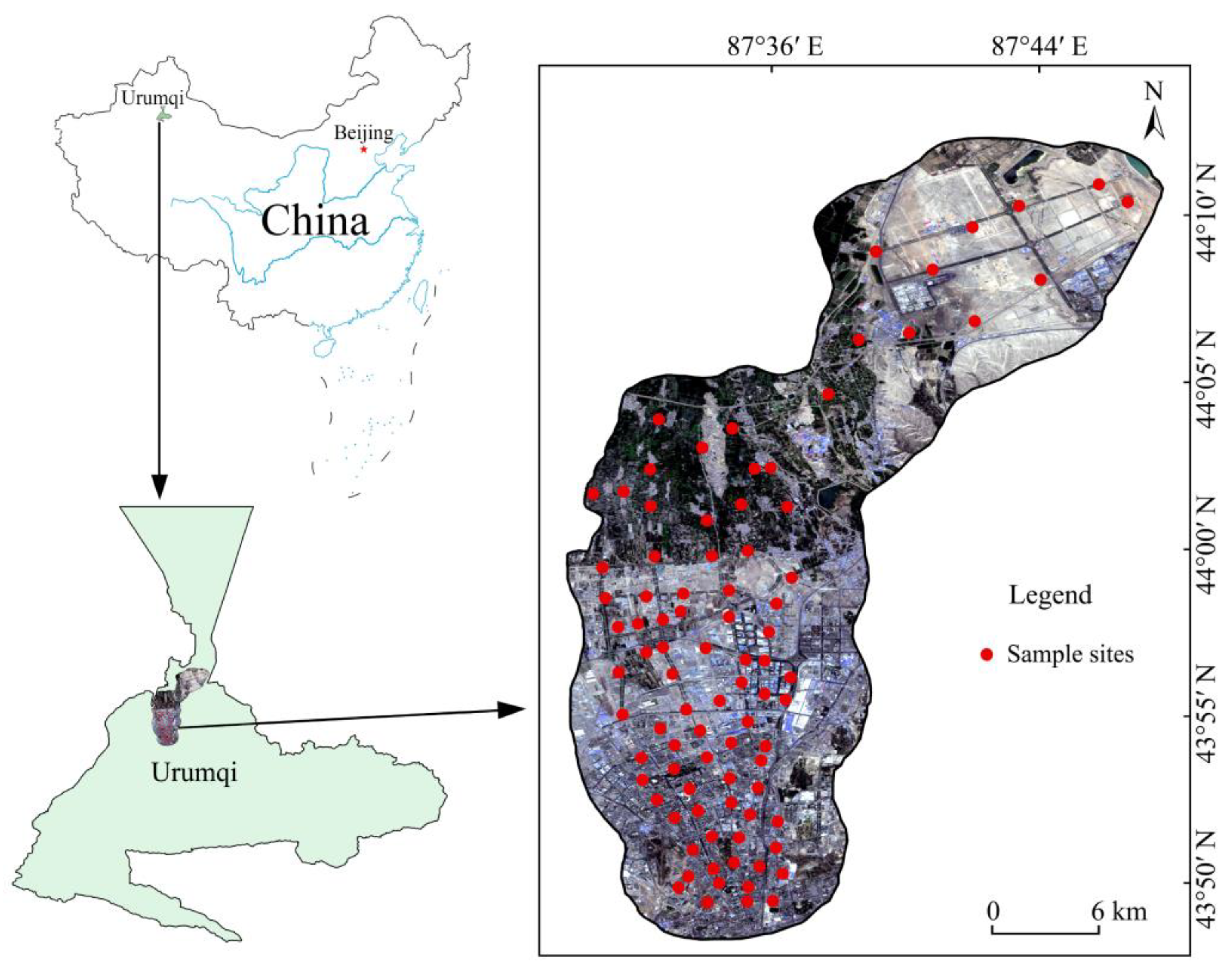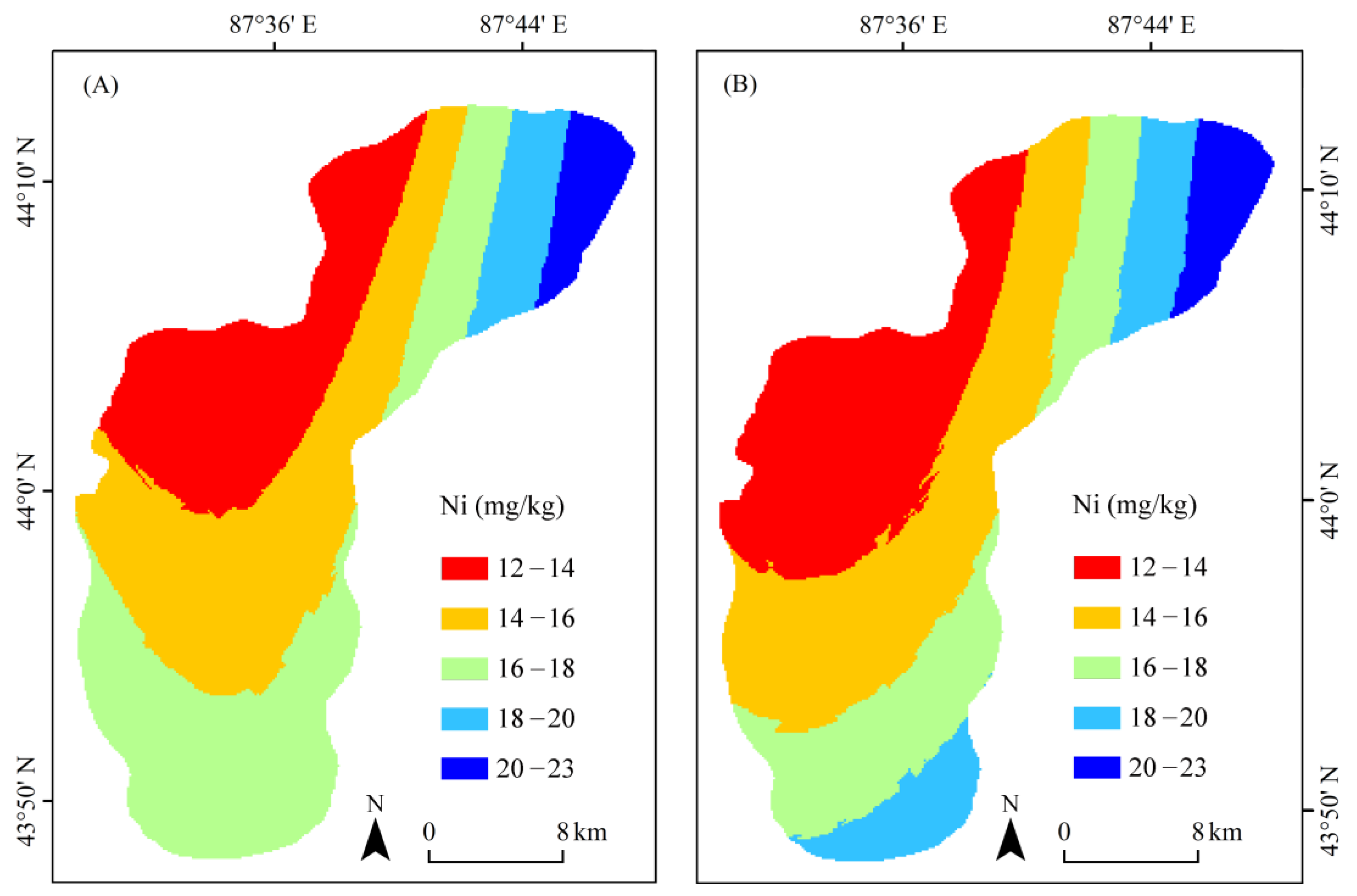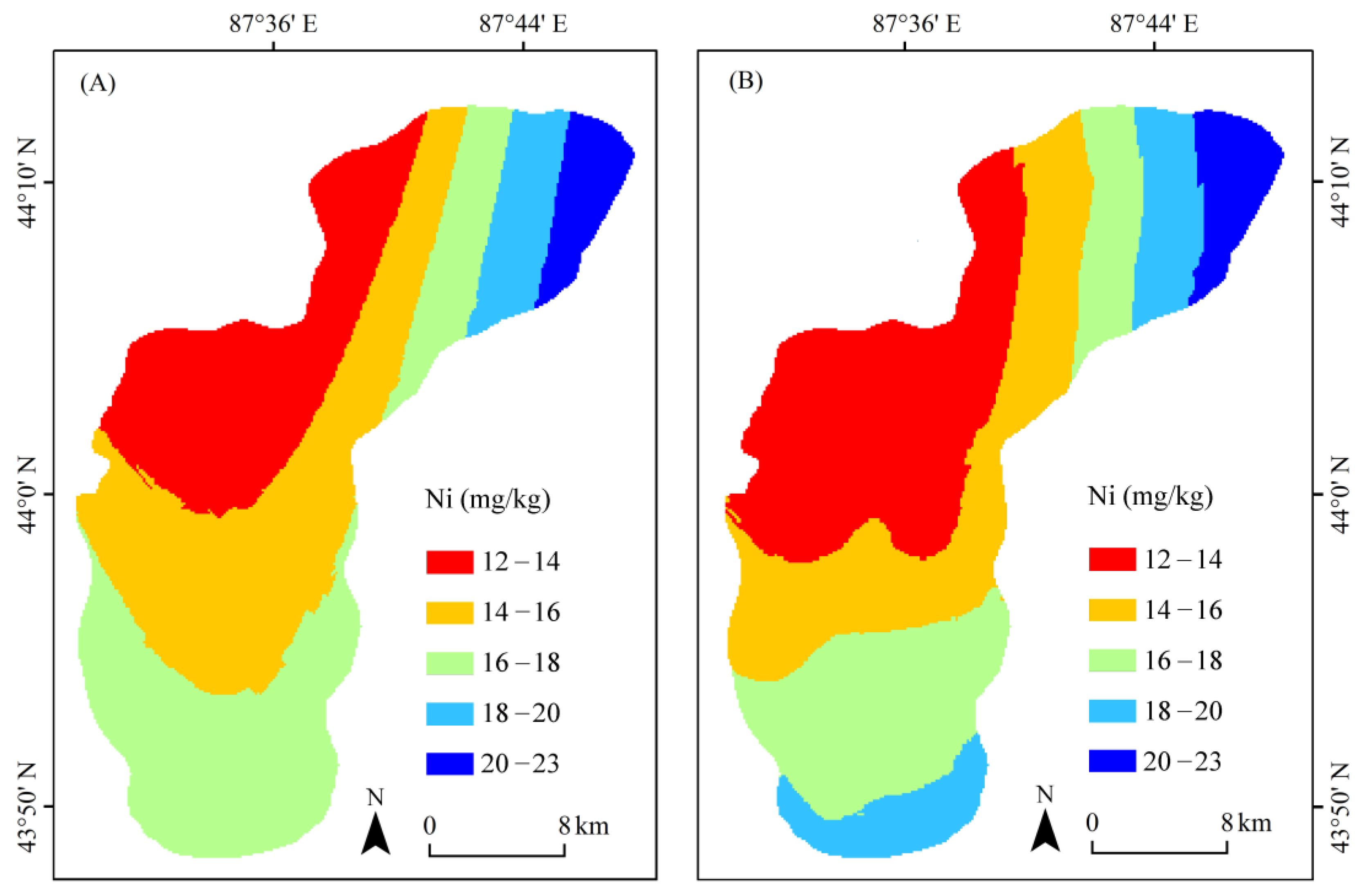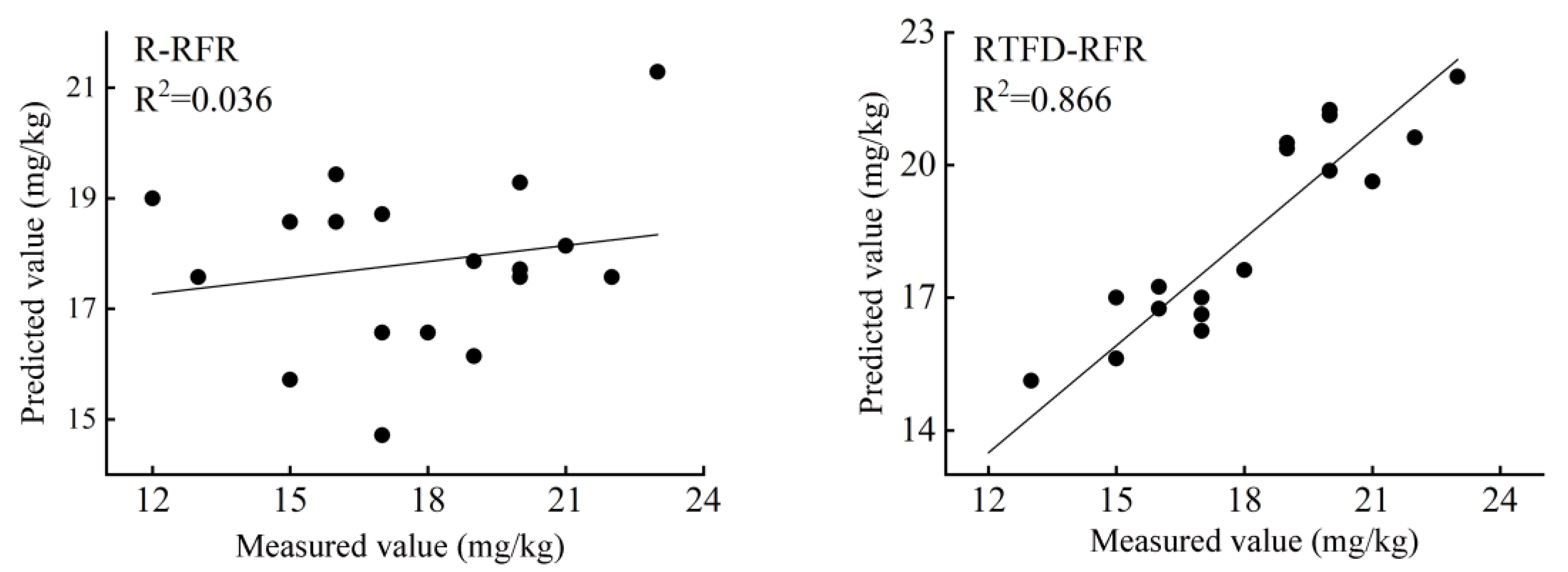Application of a Hyperspectral Remote Sensing Model for the Inversion of Nickel Content in Urban Soil
Abstract
:1. Introduction
2. Description of the Study Area
3. Experimental Data
3.1. Sample Collection and Analysis
3.2. Spectrometric Determination
4. Experimental Data
4.1. Spectral Analysis
4.1.1. Spectral Data Pre-Processing
4.1.2. Spectral Transformation
4.1.3. Important Wavelengths Selection
4.2. Modelling of Hyperspectral Inversion
4.3. Model Validation
5. Results
5.1. Statistical Analysis of Ni Content in Soil
5.2. Correlation between Ni Content and Reflectance Data of Soil
5.3. Establishment and Analysis of Hyperspectral Prediction Model
5.3.1. The Analysis of PLSR Model
5.3.2. The Analysis of RFR Model
5.3.3. The Analysis of SVMR Model
5.4. Discussion of Optimal Prediction Models
6. Conclusions
- Transformed spectral data with Pearson’s correlation coefficient analysis and the CARS method can obviously reduce the interference of the environmental background and improve the correlations between spectral reflectance data and the Ni content of soil. However, the spectral reflectance data correlate differently with the Ni content under different spectral processing methods. The first-order differentiation of the reciprocal (RTFD) has the most significant enhancement of spectral features.
- The results showed that the RTFD–RFR model is more stable and has the best inversion effects, with the highest predictive ability (R2 = 0.866, RMSE = 1.321, MAE = 0.986, RPD = 2.210) for determining the Ni content in soil in the research region. The RTFD–RFR model can be used as a means of predicting the Ni content in urban soil.
Author Contributions
Funding
Institutional Review Board Statement
Informed Consent Statement
Data Availability Statement
Conflicts of Interest
References
- World Health Organization. International Agency for Research on Cancer Group II Carcinogen List; World Health Organization: Geneva, Switzerland, 2017. [Google Scholar]
- Chen, M.Y.; Zhu, H.H.; She, W.D.; Yin, G.C.; Huang, Z.Z.; Yang, Q.L. Health risk assessment and source apportionment of soil heavy metals at a legacy shipyard site in Pearl River Delta. Ecol. Environ. Sci. 2023, 32, 794–804. [Google Scholar]
- Ning, W.J.; Xie, X.M.; Yan, L.P. Spatial distribution, sources and health risks of heavy metals in soil in Qingcheng District, Qingyuan City: Comparison of PCA and PMF model results. Earth Sci. Front. 2023, 30, 470–484. [Google Scholar]
- Guo, Z.J.; Zhou, Y.L.; Wang, Q.L. Characteristics of soil heavy metal pollution and health risk in Xiong’an New District. China Environ. Sci. 2021, 41, 431–441. [Google Scholar]
- Ajigul, M.; Mamattursun, E.; Anwar, M. Pollution risk assessment of heavy metals from farmland soils in urban-rural ecotone of Kashgar City, XinJiang. Environ. Eng. 2018, 36, 160–164. [Google Scholar]
- Li, J.; Li, X.; Li, K.M.; Jiao, L.; Tai, X.S.; Zang, F. Characteristics and identification priority source of heavy metals pollution in farmland soils in the Yellow River Basin. Environ. Sci. 2023, 44, 4406–4415. [Google Scholar] [CrossRef]
- Ali, R.; Hossein, H.; Seyedeh, B.F.M.; Nima, J. Evaluation of heavy metals concentration in Jajarm Bauxite Deposit in northeast of Iran using environmental pollution indices. Malays. J. Geosci. 2019, 12, 12–20. [Google Scholar]
- Ali, R.; Hossein, H.; Seyedeh, B.F.M.; Sara, H.; Nima, J. Assessment of heavy metals contamination in surface soils in Meiduk copper mine area, Se Iran. Earth Sci. Malays. 2019, 3, 1–8. [Google Scholar]
- Xue, Y.; Zou, B.; Wen, Y.; Tu, Y.; Xiong, L. Hyperspectral inversion of chromium content in soil using support vector machine combined with lab and field spectra. Sustainability 2020, 12, 4441. [Google Scholar] [CrossRef]
- Patel, A.K.; Ghosh, J.K.; Sayyad, S.U. Fractional abundances study of macronutrients in soil using hyperspectral remote sensing. Geocarto Int. 2020, 37, 474–493. [Google Scholar] [CrossRef]
- Yang, Y.; Cui, Q.; Jia, P.; Liu, J.; Bai, H. Estimating the heavy metal concentrations in topsoil in the Daxigou mining area, China, using multispectral satellite imagery. Sci. Rep. 2021, 11, 11718. [Google Scholar] [CrossRef]
- Ye, M.; Zhu, L.; Li, X.; Ke, Y.; Huang, Y.; Chen, B.; Yu, H.; Li, H.; Feng, H. Estimation of the soil arsenic concentration using a geographically weighted XGBoost model based on hyperspectral data. Sci. Total. Environ. 2022, 858, 159798. [Google Scholar] [CrossRef]
- Hou, L.; Li, X.; Li, F. Hyperspectral-based inversion of heavy metal content in the soil of coal mining areas. J. Environ. Qual. 2018, 48, 57–63. [Google Scholar] [CrossRef]
- Surya, S.G.; Yuvaraja, S.; Varrla, E.; Baghini, M.S.; Palaparthy, V.S.; Salama, K.N. An in-field integrated capacitive sensor for rapid detection and quantification of soil moisture. Sens. Actuators B Chem. 2020, 321, 128542. [Google Scholar] [CrossRef]
- Samuel, N.A.; Anna, F.H.; Andreas, A.; Joshua, H.V.; Teamrat, A.G. Advances in soil moisture retrieval from multispectral remote sensing using unoccupied aircraft systems and machine learning techniques. Hydrol. Earth Syst. Sci. 2021, 25, 2739–2758. [Google Scholar]
- Asmau, M.A.; Olga, D.; Yahya, Z.; Mike, S. Quantification of hydrocarbon abundance in soils using deep learning with dropout and hyperspectral data. Remote Sens. 2019, 11, 1938. [Google Scholar]
- Li, H.; Jia, S.; Le, Z. Quantitative Analysis of soil total nitrogen using hyperspectral imaging technology with extreme learning machine. Sensors 2019, 19, 4355. [Google Scholar] [CrossRef] [PubMed]
- Xu, X.; Chen, S.; Xu, Z.; Yu, Y.; Zhang, S.; Dai, R. Exploring appropriate preprocessing techniques for hyperspectral soil organic matter content estimation in black soil area. Remote Sens. 2020, 12, 3765. [Google Scholar] [CrossRef]
- Jia, P.; Zhang, J.; He, W.; Hu, Y.; Zeng, R.; Zamanian, K.; Jia, K.; Zhao, X. Combination of hyperspectral and machine learning to invert soil electrical conductivity. Remote Sens. 2022, 14, 2602. [Google Scholar] [CrossRef]
- Avdan, U.; Kaplan, G.; Matcı, D.K.; Avdan, Z.Y.; Erdem, F.; Mızık, E.T.; Demirtaş, I.K. Soil salinity prediction models constructed by different remote sensors. Phys. Chem. Earth Parts A/B/C 2022, 128, 103230. [Google Scholar] [CrossRef]
- Jia, P.; Zhang, J.; He, W.; Yuan, D.; Hu, Y.; Zamanian, K.; Jia, K.; Zhao, X. Inversion of different cultivated soil types’ salinity using hyperspectral data and machine learning. Remote Sens. 2022, 14, 5639. [Google Scholar] [CrossRef]
- Wei, L.; Pu, H.; Wang, Z.; Yuan, Z.; Yan, X.; Cao, L. Estimation of soil arsenic content with hyperspectral remote sensing. Sensors 2020, 20, 4056. [Google Scholar] [CrossRef] [PubMed]
- Tan, K.; Ma, W.; Chen, L.; Wang, H.; Du, Q.; Du, P.; Yan, B.; Liu, R.; Li, H. Estimating the distribution trend of soil heavy metals in mining area from HyMap airborne hyperspectral imagery based on ensemble learning. J. Hazard. Mater. 2021, 401, 123288. [Google Scholar] [CrossRef] [PubMed]
- Xia, F.; Peng, J.; Wang, Q.L.; Zhou, L.Q.; Shi, Z. Prediction of heavy metal content in soil of cultivated land: Hyperspectral technology at provincial scale. J. Infrared Millim. Waves 2015, 34, 594–600. [Google Scholar]
- Zhao, Y.L.; Yang, N.N.; Zhang, H.X.; Wang, X.J.; Sun, X.Y.; Wang, W. Study on the statistical estimation model of soil heavy metals in Handan city based on hyper-spectral. Ecol. Environ. Sci. 2020, 29, 819–826. [Google Scholar]
- Guo, X.F.; Cao, Y.; Jiao, R.C.; Nan, Y.; Zhao, Y.F.; Ding, X. An inversion of soil nickel contents with hyperspectral in iron mine area of Beijing. Chin. J. Soil Sci. 2021, 52, 960–967. [Google Scholar]
- Wang, F.H.; Lu, J.H.; Liu, Z.W.; Wang, D.Q.; Li, X.C. Estimation of soil heavy metal nickel in Yantai District based on hyperspectral data. J. Shandong Agric. Univ. (Nat. Sci. Ed.) 2019, 50, 84–87. [Google Scholar]
- Ni, B.; Huang, Z.Q.; Jiang, M.; Zhang, Y.L.; Zhu, F.X. Retrieval of heavy metal nickel content in farmland soil in the southwest of Xiong’an New District based on aerial hyperspectral CASI & SASI data. Geol. Explor. 2022, 58, 1307–1320. [Google Scholar]
- Nazupar, S.; Mamattursun, E.; Li, X.; Wang, Y. Spatial distribution, contamination levels, and health risks of trace elements in topsoil along an urbanization gradient in the city of Urumqi, China. Sustainability 2022, 14, 12646–12663. [Google Scholar]
- Wei, B.; Jiang, F.; Li, X.; Mu, S. Spatial distribution and contamination assessment of heavy metals in urban road dust from Urumqi, NW China. Microchem. J. 2002, 93, 147–152. [Google Scholar] [CrossRef]
- CMEPRC (Ministry of Environmental Protection of the People’s Republic of China). Soil and Sediment—Determination of Aqua Regia Extracts of 12 Metal Elements—Inductively Coupled Plasma Mass Spectrometry, HJ 803–2016. 2016. Available online: https://www.doc88.com/p-3357828192459.html (accessed on 15 January 2019).
- Michelle, D.; Onisimo, M.; Riyad, I. Examining the utility of random forest and AISA Eagle hyperspectral image data to predict Pinus patula age in KwaZulu-Natal, South Africa. Geocarto Int. 2011, 26, 275–289. [Google Scholar]
- Yuan, Z.R.; Wei, L.F.; Zhang, Y.X.; Yu, M.; Yan, X.R. Hyperspectral inversion and analysis of heavy metal arsenic content in farmland soil based on optimizing CARS combined with PSO-SVM algorithm. Spectrosc. Spectr. Anal. 2020, 40, 567–573. [Google Scholar]
- Zhong, X.J.; Yang, L.; Zhang, D.X.; Cui, T.; He, X.T.; Du, Z.H. Effect of different particle sizes on the prediction of soil organic matter content by visible-near infrared spectroscopy. Spectrosc. Spectr. Anal. 2022, 42, 2542–2550. [Google Scholar]
- Ma, X.; Zhou, K.; Wang, J.; Cui, S.; Zhou, S.; Wang, S.; Zhang, G. Optimal bandwidth selection for retrieving Cu content in rock based on hyperspectral remote sensing. J. Arid. Land 2022, 14, 102–114. [Google Scholar] [CrossRef]
- Breiman, L. Random Forest. Mach. Learn 2001, 45, 5–32. [Google Scholar] [CrossRef]
- Han, L.; Chen, R.; Zhu, H.; Zhao, Y.; Liu, Z.; Huo, H. Estimating soil arsenic content with visible and near-infrared hyperspectral reflectance. Sustainability 2020, 12, 1476. [Google Scholar] [CrossRef]
- Rukeya, S.; Nijat, K.; Abdugheni, A.; Li, H.; Ahunaji, Y.; Balati, M.; Shi, Q.D. Possibility of optimized indices for the assessment of heavy metal contents in soil around an open pit coal mine area. Int. J. Appl. Earth Obs. Geoinf. 2018, 73, 14–25. [Google Scholar]
- Vohland, M.; Besold, J.; Hill, J.; Fründ, H.-C. Comparing different multivariate calibration methods for the determination of soil organic carbon pools with visible to near infrared spectroscopy. Geoderma 2011, 166, 198–205. [Google Scholar] [CrossRef]
- Wang, Y.; Niu, R.; Lin, G.; Xiao, Y.; Ma, H.; Zhao, L. Estimate of soil heavy metal in a mining region using PCC-SVM-RFECV-AdaBoost combined with reflectance spectroscopy. Environ. Geochem. Health 2023. online ahead of print. [Google Scholar] [CrossRef]
- Liu, W.; Li, M.; Zhang, M.; Long, S.; Guo, Z.; Wang, H.; Li, W.; Wang, D.; Hu, Y.; Wei, Y.; et al. Hyperspectral inversion of mercury in reed leaves under different levels of soil mercury contamination. Environ. Sci. Pollut. Res. 2020, 27, 22935–22945. [Google Scholar] [CrossRef]
- Zhou, M.; Zou, B.; Tu, Y.; Feng, H.; He, C.; Ma, X.; Ning, J. Spectral response feature bands extracted from near standard soil samples for estimating soil Pb in a mining area. Geocarto Int. 2022, 37, 13248–13267. [Google Scholar] [CrossRef]
- Chen, H.W.; Chen, C.-Y.; Nguyen, K.L.P.; Chen, B.-J.; Tsai, C.-H. Hyperspectral sensing of heavy metals in soil by integrating AI and UAV technology. Environ. Monit. Assess. 2022, 194, 518. [Google Scholar] [CrossRef] [PubMed]
- Zhang, S.; Shen, Q.; Nie, C.; Huang, Y.; Wang, J.; Hu, Q.; Ding, X.; Zhou, Y.; Chen, Y. Hyperspectral inversion of heavy metal content in reclaimed soil from a mining wasteland based on different spectral transformation and modeling methods. Spectrochim. Acta Part A Mol. Biomol. Spectrosc. 2019, 211, 393–400. [Google Scholar] [CrossRef] [PubMed]
- Yang, H.; Xu, H.; Zhong, X. Study on the hyperspectral retrieval and ecological risk assessment of soil Cr, Ni, Zn heavy metals in tailings area. Bull. Environ. Contam. Toxicol. 2022, 108, 745–755. [Google Scholar] [CrossRef] [PubMed]







| Data Set | Samples/n | Minimum | Maximum | Average | SD | CV |
|---|---|---|---|---|---|---|
| Modeling set (mg/kg) | 70 | 10.00 | 29.00 | 18.71 | 3.59 | 0.19 |
| Validation set (mg/kg) | 18 | 12.00 | 23.00 | 17.78 | 2.92 | 0.16 |
| Total (mg/kg) | 88 | 10.00 | 29.00 | 18.52 | 3.49 | 0.19 |
| Transformation | PCC | CARS | ||||||
|---|---|---|---|---|---|---|---|---|
| R2 | RMSE | MAE | RPD | R2 | RMSE | MAE | RPD | |
| R | 0.012 | 3.032 | 1.520 | 0.963 | 0.495 | 2.073 | 1.316 | 1.409 |
| RMSFD | 0.571 | 1.910 | 1.271 | 1.529 | 0.736 | 1.498 | 1.144 | 1.949 |
| RMSSD | 0.394 | 2.271 | 1.364 | 1.286 | 0.638 | 1.756 | 1.187 | 1.663 |
| LTFD | 0.514 | 2.033 | 1.300 | 1.436 | 0.615 | 1.810 | 1.228 | 1.613 |
| LTSD | 0.417 | 2.226 | 1.349 | 1.312 | 0.492 | 2.079 | 1.255 | 1.405 |
| RLFD | 0.567 | 1.919 | 1.300 | 1.522 | 0.537 | 1.986 | 1.287 | 1.470 |
| RLSD | 0.436 | 2.191 | 1.357 | 1.333 | 0.556 | 1.942 | 1.246 | 1.504 |
| RTFD | 0.585 | 1.880 | 1.248 | 1.553 | 0.545 | 1.968 | 1.278 | 1.484 |
| RTSD | 0.413 | 2.235 | 1.331 | 1.306 | 0.671 | 1.673 | 1.149 | 1.745 |
| ATFD | 0.515 | 2.032 | 1.299 | 1.437 | 0.566 | 1.921 | 1.309 | 1.520 |
| ATSD | 0.419 | 2.224 | 1.346 | 1.313 | 0.680 | 1.651 | 1.144 | 1.769 |
| FD | 0.603 | 1.838 | 1.249 | 1.589 | 0.388 | 2.282 | 1.288 | 1.280 |
| SD | 0.385 | 2.287 | 1.390 | 1.277 | 0.603 | 1.837 | 1.197 | 1.590 |
| Transformation | PCC | CARS | ||||||
|---|---|---|---|---|---|---|---|---|
| R2 | RMSE | MAE | RPD | R2 | RMSE | MAE | RPD | |
| R | 0.036 | 9.096 | 2.563 | 0.321 | 0.755 | 2.083 | 1.222 | 1.402 |
| RMSFD | 0.774 | 1.924 | 1.056 | 1.518 | 0.461 | 4.587 | 1.783 | 0.637 |
| RMSSD | 0.807 | 1.644 | 1.030 | 1.776 | 0.725 | 2.341 | 1.177 | 1.247 |
| LTFD | 0.582 | 3.556 | 1.467 | 0.821 | 0.408 | 5.037 | 1.910 | 0.580 |
| LTSD | 0.792 | 1.767 | 1.037 | 1.653 | 0.732 | 2.281 | 1.171 | 1.280 |
| RLFD | 0.762 | 2.027 | 1.167 | 1.441 | 0.546 | 3.864 | 1.561 | 0.756 |
| RLSD | 0.735 | 2.253 | 1.217 | 1.296 | 0.756 | 2.077 | 1.133 | 1.406 |
| RTFD | 0.866 | 1.321 | 0.986 | 2.210 | 0.684 | 2.691 | 1.198 | 1.085 |
| RTSD | 0.673 | 2.784 | 1.278 | 1.049 | 0.722 | 2.364 | 1.241 | 1.235 |
| ATFD | 0.622 | 3.219 | 1.414 | 0.907 | 0.425 | 4.889 | 1.979 | 0.597 |
| ATSD | 0.740 | 2.212 | 1.121 | 1.320 | 0.837 | 1.388 | 0.958 | 2.104 |
| FD | 0.649 | 2.984 | 1.472 | 0.979 | 0.453 | 4.652 | 1.701 | 0.628 |
| SD | 0.762 | 2.020 | 1.079 | 1.446 | 0.783 | 1.850 | 1.063 | 1.578 |
| Transformation | PCC | CARS | ||||||
|---|---|---|---|---|---|---|---|---|
| R2 | RMSE | MAE | RPD | R2 | RMSE | MAE | RPD | |
| R | 0.071 | 2.963 | 2.415 | 0.985 | 0.242 | 2.540 | 2.085 | 1.150 |
| RMSFD | 0.621 | 1.795 | 1.476 | 1.627 | 0.106 | 2.757 | 2.120 | 1.059 |
| RMSSD | 0.594 | 1.859 | 1.464 | 1.571 | 0.574 | 1.903 | 1.468 | 1.534 |
| LTFD | 0.596 | 1.853 | 1.485 | 1.576 | 0.122 | 2.733 | 2.200 | 1.068 |
| LTSD | 0.611 | 1.819 | 1.425 | 1.605 | 0.612 | 1.816 | 1.359 | 1.608 |
| RLFD | 0.630 | 1.774 | 1.457 | 1.646 | 0.198 | 2.612 | 2.084 | 1.118 |
| RLSD | 0.627 | 1.781 | 1.405 | 1.640 | 0.630 | 1.774 | 1.353 | 1.646 |
| RTFD | 0.412 | 2.237 | 1.706 | 1.305 | 0.212 | 2.589 | 1.962 | 1.128 |
| RTSD | 0.576 | 1.898 | 1.495 | 1.538 | 0.611 | 1.820 | 1.395 | 1.604 |
| ATFD | 0.597 | 1.850 | 1.483 | 1.578 | 0.181 | 2.640 | 2.071 | 1.106 |
| ATSD | 0.648 | 1.730 | 1.408 | 1.688 | 0.593 | 1.861 | 1.437 | 1.569 |
| FD | 0.635 | 1.761 | 1.426 | 1.658 | 0.322 | 2.402 | 1.867 | 1.216 |
| SD | 0.605 | 1.834 | 1.425 | 1.592 | 0.504 | 2.055 | 1.605 | 1.421 |
Disclaimer/Publisher’s Note: The statements, opinions and data contained in all publications are solely those of the individual author(s) and contributor(s) and not of MDPI and/or the editor(s). MDPI and/or the editor(s) disclaim responsibility for any injury to people or property resulting from any ideas, methods, instructions or products referred to in the content. |
© 2023 by the authors. Licensee MDPI, Basel, Switzerland. This article is an open access article distributed under the terms and conditions of the Creative Commons Attribution (CC BY) license (https://creativecommons.org/licenses/by/4.0/).
Share and Cite
Zhong, Q.; Eziz, M.; Sawut, R.; Ainiwaer, M.; Li, H.; Wang, L. Application of a Hyperspectral Remote Sensing Model for the Inversion of Nickel Content in Urban Soil. Sustainability 2023, 15, 13948. https://doi.org/10.3390/su151813948
Zhong Q, Eziz M, Sawut R, Ainiwaer M, Li H, Wang L. Application of a Hyperspectral Remote Sensing Model for the Inversion of Nickel Content in Urban Soil. Sustainability. 2023; 15(18):13948. https://doi.org/10.3390/su151813948
Chicago/Turabian StyleZhong, Qing, Mamattursun Eziz, Rukeya Sawut, Mireguli Ainiwaer, Haoran Li, and Liling Wang. 2023. "Application of a Hyperspectral Remote Sensing Model for the Inversion of Nickel Content in Urban Soil" Sustainability 15, no. 18: 13948. https://doi.org/10.3390/su151813948







